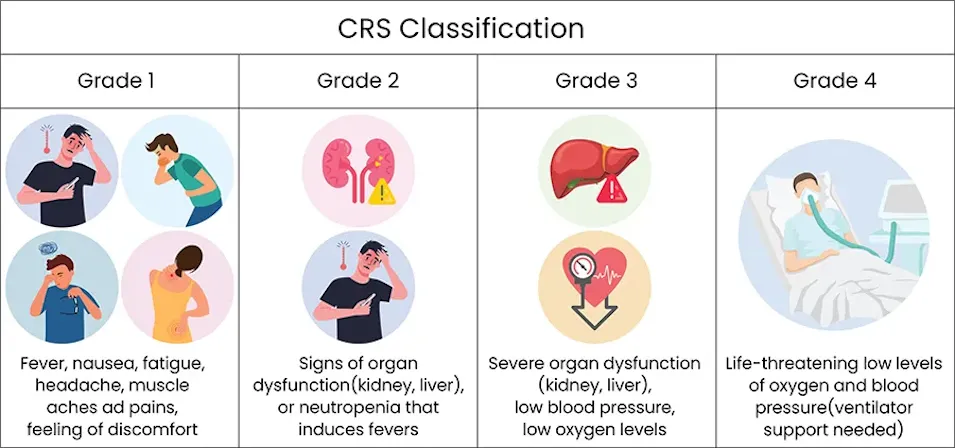Cytokine Release Syndrome (CRS)
Cytokine release syndrome (CRS) is a side effect of CAR T-cell therapy. Because CAR T-cell therapy positively manipulates the immune system, there is a risk of an immune overreaction. The immune system will recognize the threat (the CLL cell) and work to attack it, but there are times when it goes into “overdrive.”
Your body prompts the immune system to release certain chemicals called cytokines, and the level of those cytokines within the body can negatively affect you to varying degrees.
CRS symptoms vary depending on the grade in which they are experienced. They can range from a fever to extremely low blood pressure that prompts an ICU stay.
Treatment for CRS includes a tocilizumab injection and corticosteroids.
How is CRS Severity Classified?

Grade 1
This is a mild reaction. It can present as fever, nausea, fatigue, headache, muscle aches and pains, or a general feeling of discomfort or uneasiness. Treatments usually include fluids, antipyretics (such as ibuprofen or aspirin), or antiemetics (for nausea or vomiting).
Grade 2
This is a moderate reaction. There can be some signs of organ dysfunction (such as kidney or liver dysfunction), or neutropenia that induces fevers. Your team might give you steroids, put you on oxygen, or give you liquid IVs. Tocilizumab is a drug commonly used to treat CRS (cytokine release syndrome) and manage the side effects to keep it from progressing to Grades 3 or 4.
Grade 3
This is a severe reaction. Symptoms might include severe organ dysfunction (such as kidney or liver), low blood pressure that has been treated with intravenous fluids but is not resolving, or low oxygen levels. You will most likely be moved to the ICU at this time for observation and treatment and be placed on oxygen.
Grade 4
These include life-threatening low levels of oxygen or blood pressure. There are life-threatening consequences, and ventilator support will need to be used at this time.
What Risk Factors Contribute to More Serious Grades of CRS?
The risk and severity of CRS are higher in people with CLL who have a greater disease burden before CAR T-cell therapy. In other words, the higher the number of CLL cells before the treatment is administered, the greater the risk of serious CRS response.
This is why, often, when your CLL counts are high at the time you qualify for CAR T-cell therapy, some kind of chemotherapy will be given before the CAR T-cell therapy is administered to lower the number of CLL cells in your body. Talk to your doctor if you think this applies to you to see what your options are.